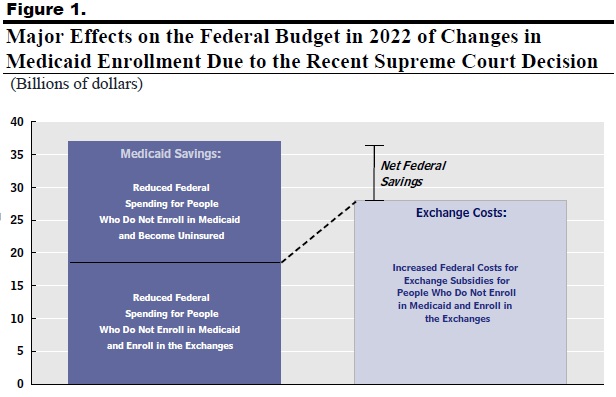Updated Estimates of the Affordable Care Act
Today, the Congressional Budget Office released two reports revising estimates for the Affordable Care Act (ACA). The first report provides updated estimates specifically for the coverage provisions in the ACA, to reflect the impact of the recent Supreme Court ruling on the ACA’s Medicaid expansion. The second report estimates various revenue and outlays effects from repealing the entire Affordable Care Act, as per HR 6079 which passed the House earlier this month, including updates from the Court’s ruling. Here are the main take-aways from the reports:
- The Supreme Court ruling is expected to reduce ACA net costs by $84 billion from 2013-2022.
- Repeal of the full ACA would add an estimated $109 billion to cumulative deficits over the 2013-2022 period.
- ACA requirements are expected to increase IRS and HHS administrative costs by $10-20 billion over ten years, which do not score as having a budgetary effect because discretionary spending is already capped by the Budget Control Act.
- Some future ACA spending has already been shaped both by obligations already contracted for future years on the one hand (and therefore missing from the new score for repeal, after their pre-obligation inclusion in CBO’s 2011 score for repeal), and by ACA-mandated savings practices already introduced on the other. CBO reports neither these last estimates nor their net directional impact on the deficit, but it notes that for these and other reasons, the net fiscal impact of the Affordable Care Act does not equal the reverse of the estimated fiscal impact of repeal.
The Supreme Court overturned the part of the ACA that would have allowed the federal government to withhold all Medicaid funding (from the entire program) from any states that refused the Medicaid expansion.
Due to the Supreme Court ruling about the Medicaid expansion and the states, CBO has revised its March estimate for net coverage provision costs downward by $84 billion to $1,168 billion for the eleven years, 2012-2022. According to the report, this decrease is a result of lower Medicaid enrollment (savings $289 billion, and an additional $5 billion in penalty payments) which CBO expects to more than offset the increase in consequent costs from greater participation in exchange subsidies (adding $210 billion in costs).

Source: CBO
Although six governors in Florida, Louisiana, Mississippi, Nebraska, South Carolina, and Texas have already announced their intent not to expand their Medicaid programs, CBO did not make state-by-state predictions, due to the high degree of uncertainty associated with state decisions. Instead, CBO chose “the middle of the distribution of possible outcomes”: they projected that one-third of the newly eligible population would be in states that fully undertook the expansion; one-half of the population would be in states that partially undertook the expansion (mostly to exactly the poverty line); and one-sixth of the population would be in states that eschewed the expansion. In terms of coverage impact, as was expected, fewer people will be covered under Medicaid (6 million in both 2014 and 2022), more will be covered through the exchanges (2 million in 2014, 3 million in 2022), and more will be uninsured (4 million in 2014, 3 million in 2022).
CBO has also updated its cost estimate for H.R. 6079, repeal of the Affordable Care Act. The total estimated cost of repeal is now $109 billion for 2013-2022, compared to the February 2011 estimate that repeal would add $210 billion to deficits, from 2012-2021. As before, the ACA starts with net annual deficit reduction over the 2012-2015 period, then shifts to net deficit increases the next two or three years before settling into net deficit reduction of greater amounts each year.
Beyond the $84 billion change due to the Supreme Court’s ruling, the overall cost of repealing ACA has changed since 2011 in other ways, which have resulted in more than $100 billion in additional spending on coverage provisions and $34 billion of increased revenue than projected in 2011 for 2013-2021. In addition, the decision by the Administration not to proceed with implementing the CLASS Act, a long-term care insurance program, reduced the cost of repeal by about $85 billion over ten years, because it would have raised substantial revenue through 2021, with outlays increasing in later decades. There have also been downward revisions to health care spending trends, meaning that the Medicare savings are lower (since there is less spending to cut) and the revenue raised from the health insurance excise tax is lower. In addition, as discussed above, some elements from ACA have already been obligated, and the time window for evaluating the budgetary effects has shifted from 2012-2021 to 2013-2022.


